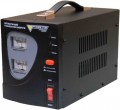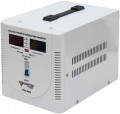Power
Maximum apparent load power allowed for this model
In electrical engineering, full power is called, which takes into account both active and reactive power; the first type of power is discussed above, and the second can be described as the effect of windings, inductors and capacitors on the operation of AC networks. Apparent power is the main parameter for calculating loads on equipment in professional electrical engineering; it is usually denoted in volt-amperes (VA), in the case of stabilizers — in kilovolt-amperes (kVA). Note that for convenience, different types of power in electrical engineering are denoted by units with different names. That is why the power in W indicated in the characteristics of the stabilizer is usually not equal to its power in VA.
When choosing a stabilizer for some household appliances, it is quite enough to have active power data, but if possible it is better to use the full one. In particular, it is this parameter that is key when looking for
a stabilizer for a refrigerator or
a stabilizer for a boiler : in the first case, 0.4 – 1 kVA is considered the optimal value, in the second — from 0.1 to 0.7 kVA. However, anyway, it is necessary to choose a specific model in such a way that its total power is not lower than the total power of the entire connected load — and it is better to have a reserve (in case of unforeseen circumstances or connecting additional eq
...uipment). At the same time, note that powerful models are distinguished by large dimensions and weight, and most importantly, high cost; therefore, it does not always make sense to chase the maximum numbers.
Also note that there are formulas that allow you to derive the optimal total power of the stabilizer based on data on active power and type of load; they can be found in special sources.Voltmeter
The type of voltmeter provided in the design of the stabilizer, or rather — the type of scale used by this device. This
voltmeter itself allows monitoring of voltage — usually both at the input and output — which facilitates control over the stabilizer's operation. For this purpose, two separate scales are most often provided, but there are also "single" voltmeters with a switch to choose between input and output voltage. As for the type of scales, the following options are available:
— Analog. Analog voltmeters are equipped with a traditional type of scale — with divisions marked on it and a needle. They are simpler and cheaper than digital ones, but less accurate — even in the most precise devices, the error in readings can be 5-10 V just due to the peculiarities of reading information from such a scale. In some inexpensive models, analog voltmeters serve more as general indicators rather than precise instruments. At the same time, for most everyday tasks, such accuracy is quite sufficient.
— Digital. In such voltmeters, the role of the scale is played by a digital
display, where voltage values can be displayed with an accuracy of up to a volt — this is the main advantage of this option over analog. The drawbacks include the complexity and relatively high cost of digital indicators. Moreover, such high accuracy may be critical in the professional field, but in everyday life, it is not
...always necessary. Accordingly, in inexpensive low-power stabilizers, a digital voltmeter is often more of a marketing ploy than a real necessity.Grounded sockets
The number of
sockets for 230 V with grounding provided in the design of the stabilizer.
Some electrical appliances, such as refrigerators and washing/dishwashers, must be grounded when connected. This point should not be ignored — there is a risk of a serious electric shock. Accordingly, the number of sockets with grounding corresponds to the maximum number of such devices that can be simultaneously connected to the stabilizer without the use of splitters. At the same time, ungrounded devices can also be connected to such sockets.
Terminal connection
The presence in the design of the stabilizer of at least two pairs of terminals — at the input and at the output. Unlike sockets, which are designed for frequent connections and disconnections, the
terminal connection is designed to permanently secure the wires — roughly speaking, "attached — clamped — forgot." It does not involve direct connection of electrical appliances, usually the power from the terminals goes further into the mains and is already distributed through it to individual sockets in the room. Accordingly, this option is typical for powerful models (on average from 3 kVA and above, see "Power"), which are designed for installation in one place as a permanent element of the power grid. Often such stabilizers do not have their own outlets at all — only terminals.

